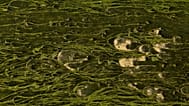MOSCOW (Reuters) - Soccer fans travelling to Kaliningrad, one of Russia's 11 World Cup host cities, could strike gold on its nearby Baltic Sea beach resorts.
Amber, known locally as 'Baltic gold', is often found washed up on the region's seafront. Hunting for the precious stones, formed by the hardening of tree resin over thousands of years, is a popular tourist activity.
"There are seasons when there are storms after which the whole beach is covered in amber," Arina, 15, a tourist from Kazakhstan, told Reuters on one of the region's beaches near the town of Yantarny, named after the Russian word for amber.
Amber was first collected and polished by people living in the Baltic Sea region between 4,000 and 1,600 years ago, according to the Kaliningrad Regional Amber Museum.
Through a process of erosion, ancient rivers lifted the fossilised resin, produced by species of trees formerly found in Europe and now extinct, and carried it to the Kaliningrad region, creating the world's largest reserves.
The Russian exclave, which borders Poland and Lithuania, is hosting four World Cup group matches, though few tourists appear to have ventured out of the city to its beachside towns, where the production and manufacturing of amber takes place.
In the seaside town of Svetlogorsk, 40 kilometres (25 miles) from Kaliningrad, artisans displayed a range of World Cup souvenirs made out of the glittering golden gem.
They include soccer balls, models of famous players and copies of the tournament's official mascot, Zabivaka the wolf.
"It was almost obligatory to create souvenirs out of amber to mark an event as significant as the World Cup, especially as amber is a very flexible material," said Liubov Muravyeva, manager of the Vtoroe Solntse shop in Svetlogorsk where the souvenir items are on display.
The region of Kaliningrad is home to around 90 percent of the world's amber, Muravyeva added.
(Writing by Polina Ivanova; Editing by Patrick Johnston)














